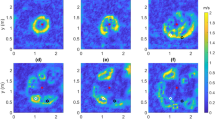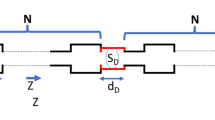Abstract
ANOTHER example of a highly sensitive flame was recently described to me which seems to show that air-currents flowing through gauze at a proper speed are sensitive without the intervention or simultaneous superaddition of a flame. A special kind of Bunsen burner was made with a spiral mixing tube coiled in an inverted cup, at the centre of which is a small chamber covered with wire-gauze at the foot of a short tube or flame-pipe. The gas is admitted by a single jet passing through a cap of wire-gauze covering the conical opening of the spiral tube, the object of this cap of gauze being to distribute the air in its approach, and to protect the gas-jet from ignition. The gas-flame burns with a small bright green cone, surmounted by a larger envelope of pale reddish flame, and it is intensely hot. The green cone indicates combustion of the most complete explosive mixture of air and coal-gas, and when the burner is properly adjusted it can only burn on the top of the flame-tube, where it finds the additional required supply of oxygen; but it descends to the wire-gauze at the foot of the tube if the air-supply exceeds, or the gas supply falls short of the right proportion. In some of these burners the slightest noise of the kind that commonly affects sensitive flames causes the cone of green flame to retreat into the tube and settle on the wire-gauze at its foot, whence it rises again immediately to the top of the tube, when the sound ceases. The explanation seems to be that the air-current entering the mixing-tube through the outer gauze cap is in a sensitive condition, and that when thrown into disturbance by the external sounds, it is more quickly seized and is drawn into the mixing tube more rapidly by the gas-jet than when it is flowing over the jet in a tranquil state. The inventor of these burners, Mr. Wallace, assures me that some of them exhibit the most sensitive of sensitive flames, and that he has more than once thought of sending one of them as a most singularly effective illustration of such flames to Prof. Tyndall.
This is a preview of subscription content, access via your institution
Access options
Subscribe to this journal
Receive 51 print issues and online access
$199.00 per year
only $3.90 per issue
Buy this article
- Purchase on SpringerLink
- Instant access to full article PDF
Prices may be subject to local taxes which are calculated during checkout
Similar content being viewed by others
Author information
Authors and Affiliations
Rights and permissions
About this article
Cite this article
HERSCHEL, A. Sounding and Sensitive Flames* II.. Nature 11, 45–47 (1874). https://doi.org/10.1038/011045a0
Issue date:
DOI: https://doi.org/10.1038/011045a0



